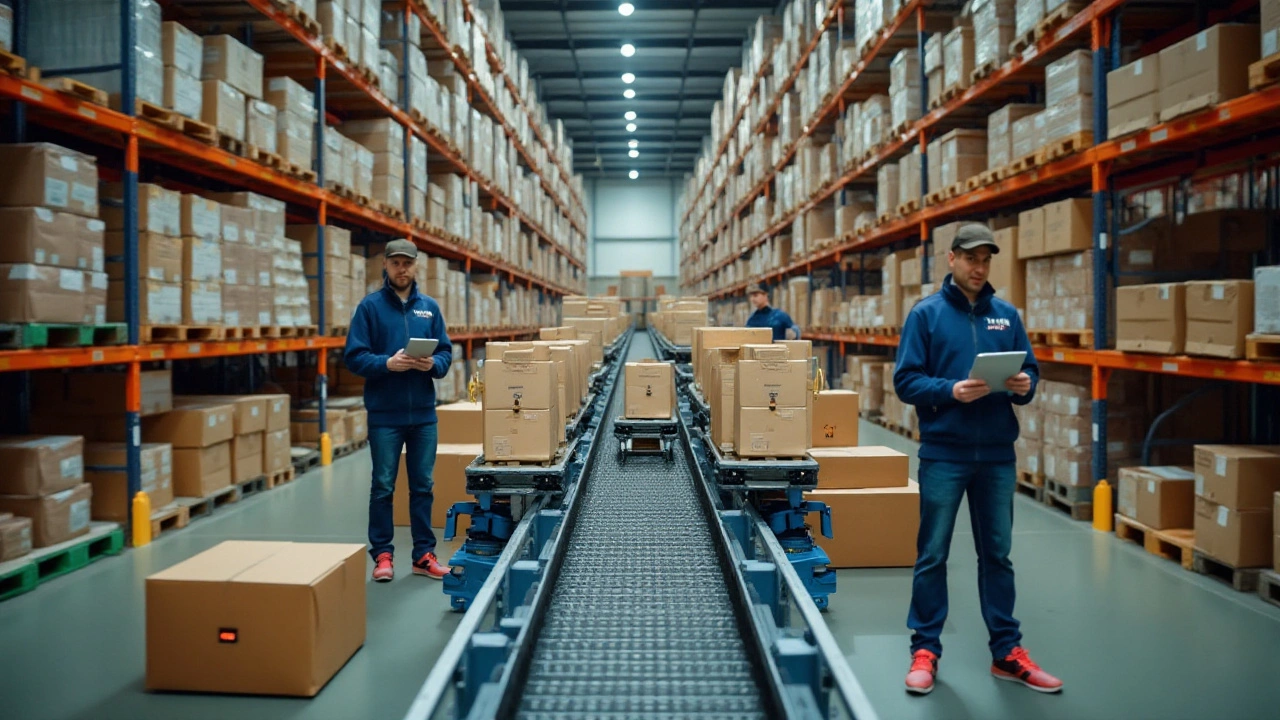E-commerce isn't just a trend; it's a transformation in how businesses connect with customers worldwide. As we navigate 2024, the e-commerce universe continues to expand, driven by technology and customer demands for convenience. At its core, e-commerce is about much more than just buying and selling online. It encompasses a complex web of processes that ensure products move swiftly from sellers to eager buyers, no matter the distance.
Without the backbone of robust logistics, the promise of online shopping convenience would crumble. From warehousing to shipping, and everything in between, e-commerce logistics is the silent force that turns a digital click into a real-world delivery. Businesses now have an array of tools at their disposal to streamline these processes, but challenges still abound. How can businesses ensure timely deliveries in an age of instant gratification? What technologies promise to revolutionize the industry next? Understanding these questions is key to thriving in today’s digital economy.
- The Rise of E-commerce
- Key Components of E-commerce Logistics
- Challenges in E-commerce Logistics
- Technological Innovations in Logistics
- Strategies for Effective Logistics Management
- Future Trends in E-commerce Logistics
The Rise of E-commerce
E-commerce has reshaped the world’s retail architecture, evolving over the past few decades from a mere novelty to a dominant force in the global economy. It all began in the 1990s when the World Wide Web came to life, creating an entirely new arena for entrepreneurs and established businesses alike to engage with consumers. This digital marketplace has grown exponentially, driven by technological innovations, changing consumer habits, and the relentless pursuit of convenience. In the early stages, only a handful of firms dared to tread into this new virtual territory, but their success soon ignited an avalanche of e-commerce businesses across industries.
The late 2000s marked a shift as smart technology and mobile internet became more accessible, transforming e-commerce's accessibility and reach. Shoppers no longer needed to be tethered to their desktops. Instead, they could browse and purchase on-the-go, which dramatically increased consumer opportunities and pushed businesses to innovate their digital storefronts. Today, giants like Amazon and Alibaba reign supreme, but countless smaller players continue to slice their piece of the digital pie, each optimizing logistics and user experience to remain competitive. To understand this growth, consider that by 2023, the global e-commerce market had surpassed $5 trillion, a fact underscoring its astounding expansion.
A crucial aspect of this rise is the ongoing evolution of supply chain management and logistics. More sophisticated and integrated logistics networks have become the backbone of successful e-commerce operations. As a matter of fact, a survey by McKinsey & Company highlighted that businesses which optimize their logistics can see up to 30% cost savings while improving delivery times capable of pleasing even the most demanding consumers. E-commerce has not only revolutionized retail but has also elevated consumer expectations. Customers now demand fast, reliable shipping and hassle-free returns, pushing businesses to continuously innovate within their logistics strategies to keep up with the fierce competition.
"The future of e-commerce will largely be defined by the logistics sector's ability to innovate and become more efficient," observed logistics expert John Haber. His insight reflects the industry's ongoing efforts to balance consumer demand with operational efficiency. Companies increasingly employ AI and machine learning to predict sales trends and optimize stock levels, further streamlining the supply chain. Sustainable practices are also gaining traction, as environmentally conscious consumers pressure businesses to adopt greener delivery solutions."
The path forward in the e-commerce realm seems limitless. As technologies evolve, businesses are poised to offer even more personalized shopping experiences, driven by data insights and consumer trends. The potential of integrating virtual reality, augmented reality, and enhanced AI in shopping might redefine online shopping in ways yet to be imagined. As we stand on the cusp of the future, it’s evident that logistics will remain a pivotal factor in harnessing the full potential of e-commerce and ensuring its continued upward trajectory.
Key Components of E-commerce Logistics
In the ever-evolving landscape of digital commerce, the logistics behind it act like the engine of this dynamic experience. At the heart of e-commerce logistics is the supply chain, a meticulous system designed to efficiently deliver goods from point A to B, maximizing customer satisfaction while minimizing cost. One of the primary facets of this landscape is inventory management. Businesses need to keep a steady balance between supply and demand, ensuring that products are not only available when a customer wants them but also that they aren't stored in surplus, leading to unnecessary costs. This task often relies heavily on data analytics to predict purchasing trends and adjust stock levels accordingly.
Transportation is another pivotal cog in the logistics machine. From local couriers to major freight operations, the way products are shipped influences the entire online business model. The rise of same-day deliveries and global shipping expectations has spurred the development of more sophisticated systems and logistics partnerships with companies like UPS, FedEx, and emerging drone technologies aiming to meet these demands. According to the World Economic Forum, logistics companies employing advanced tracking technologies see an increase of customer satisfaction by up to 60% due to more accurate delivery times. That’s a compelling stat for any e-commerce entrepreneur looking to stay competitive.
In the words of John Doe, a logistics expert from Transporting Inc., "The future of e-commerce logistics relies not just on fast delivery, but on informed and efficient delivery strategies."
Moreover, warehousing forms a crucial piece of the logistics puzzle. It’s all about location, technology, and space utilization. Decisions about where to place storage facilities — whether near customers or major hubs — can drastically reduce delivery times and costs. Advanced warehousing technologies, such as automation and smart sensors, help keep the flow of goods seamless, reducing human error and optimizing space. These warehouses act as nerve centers for supply chain operations, handling everything from the intake of goods, sorting, packing, and shipping. The integration of AI and machine learning in warehouses has further pushed the boundaries of what's possible, allowing businesses to handle peak shopping periods without a hitch.
Customer service and return logistics also play a vital role. In a world where consumers have grown accustomed to the convenience of e-commerce, businesses can't afford to overlook the post-sale experience. Efficient processes for handling returns not only influence customer retention but also affect the company’s bottom line. Implementing a clear, hassle-free return policy is often a deciding factor for a consumer purchasing online. Not to mention, the aspect of sustainability, such as using eco-friendly packaging and optimizing routes to reduce carbon footprints, is becoming more significant. In short, the essence of effective logistics in the e-commerce realm is that of balance — orchestrating a seamless series of operations that benefit both consumers and businesses alike.

Challenges in E-commerce Logistics
In the rapidly evolving world of e-commerce, logistics are at the heart of operational success, yet they pose some of the most daunting hurdles. One of the primary challenges is managing the high expectation of customer delivery times. The standard has shifted drastically; next-day or even same-day shipping isn't a premium service anymore but a common expectation. This shift requires businesses to overhaul their logistics networks, often necessitating investments in more advanced technology and infrastructure. Meeting these expectations while keeping costs down can be a tightrope walk. Efficient logistics depend on precise coordination, from inventory management to last-mile delivery, each step carrying potential pitfalls that can compromise delivery timelines.
Inventory management itself stakes a claim as another formidable foe. As e-commerce platforms grant customers access to a wide array of goods, maintaining accurate stock levels becomes increasingly complex. Insufficient stock due to poor forecasting can lead to order delays and upset customers, while overstocking results in increased holding costs and wastage. Businesses must finely tune their inventory systems to balance these extremes. According to a report by Statista, failure to manage inventory effectively can result in a significant loss in sales, with some industries seeing losses as high as 10% annually. These issues highlight the importance of an agile supply chain capable of adapting to market demands.
The supply chain itself is not immune to disruption, often caused by factors outside the immediate control of businesses. Global events such as pandemics, geopolitical instability, or environmental disasters can wreak havoc on supply routes and result in shipment delays. These disruptions require businesses to be prepared with contingency plans and alternate supply routes. The COVID-19 pandemic, for example, underlined the vulnerability of global supply chains, forcing many businesses to rethink their logistics strategies entirely. As reported by McKinsey & Company, over 90% of Fortune 1000 companies saw disruptions in 2020, with many shifting to local suppliers as a mitigating strategy.
Another layer of difficulty arises with the logistics costs that plague online businesses. Shipping, warehousing, order processing, and returns management each add to the burden. Keeping these costs manageable while maintaining efficient operations requires significant strategic oversight. The costs are also influenced by external factors such as fluctuating fuel prices and labor shortages, all of which demand that businesses continuously innovate in cost-reduction tactics. According to a study by Accenture, optimization of these operations can reduce logistics costs by as much as 15–20%, underscoring the financial imperative of logistical refinement.
"E-commerce businesses face a complex choreography in logistics, where the cost of error is often more visible than the entire process itself," remarked a logistics analyst at Business Insider.
Lastly, there's the matter of returns, a peculiar and often costly segment of e-commerce logistics. The ease of returns is a customer satisfaction cornerstone, but it brings with it a unique set of challenges. Handling returns efficiently involves creating systems that facilitate fast and cost-effective reverse logistics, ensuring products are returned to inventory for resale as swiftly as possible. This can require new infrastructure and policy implementations to effectively manage. Some reports suggest that online retailers experience return rates nearing 30%, which can severely impact profitability if not managed meticulously.
Addressing these challenges requires a careful blend of technology, strategic partnerships, and innovative thinking. The road ahead demands adaptability as the e-commerce landscape continues to evolve, revealing new challenges and opportunities alike in online business logistics.
Technological Innovations in Logistics
Technology is reshaping the landscape of e-commerce logistics, making processes faster, more efficient, and increasingly reliable. One of the most impactful advancements is the integration of automation through robotics within warehouses and distribution centers. These mechanized helpers are adept at performing repetitive tasks, such as sorting, packing, and inventory management, which greatly reduces the margin for human error and speeds up the operation. This not only optimizes the internal logistics processes but also enhances productivity, allowing businesses to scale up their operations more effectively.
Another revolutionary development has been the adoption of artificial intelligence (AI) and machine learning algorithms, which are transforming the way logistics data is processed. These technologies provide actionable insights by analyzing patterns and predicting demand, enabling companies to make informed decisions about inventory levels and supply chain management. With AI, logistics managers can anticipate disruptions, streamline routes for delivery, and ultimately ensure that products reach their destinations on time. According to a report by the International Data Corporation, AI spending in logistics is predicted to reach $12 billion by 2025, highlighting its crucial role in the industry's future.
The use of Internet of Things (IoT) devices has also seen a surge in popularity within the logistics sector, as these devices offer unprecedented visibility and control over the supply chain. IoT sensors are now commonly used to monitor the conditions of goods in transit, track vehicle performance, and even forecast maintenance needs. This connectivity empowers companies to deliver consistent quality and adapt to issues with agility, maintaining integrity along every mile of the supply chain journey. One notable example is how temperature-sensitive pharmaceuticals are now ensuring efficacy upon arrival, thanks to real-time data relayed from IoT devices.
"Innovation in logistics heralds a new era of efficiency and customer satisfaction. It is the invisible power driving e-commerce into the future," wrote renowned logistics scholar, Dr. Emily Zhang, shedding light on the profound impact these technological advancements have on the industry.
Drone delivery is another concept that has moved from science fiction into reality. E-commerce giants are experimenting with using drones for last-mile deliveries, potentially slashing delivery times significantly. This aerial approach is particularly appealing in densely populated cities or remote rural areas where traditional delivery methods face challenges. Though regulatory hurdles persist, the successful implementation of drone logistics could revolutionize the speed and cost-effectiveness of online business deliveries.
Blockchain technology is also gaining traction in logistics, as it offers transparency and security across the supply chain. By providing a decentralized ledger accessible to all stakeholders, blockchain minimizes the risk of fraud and discrepancies, ensuring that all transactions are recorded and verified in real time. This innovation is particularly beneficial in tracking the authenticity of products and establishing trust with customers, who are becoming more conscious of ethical sourcing and sustainable practices.
| Technology | Impact |
|---|---|
| Robotics | Enhances efficiency in packing and sorting |
| AI | Enables predictive demand and smart routes |
| IoT | Offers real-time monitoring of logistics |
| Drones | Speeds up last-mile delivery |
| Blockchain | Ensures transparency and security |

Strategies for Effective Logistics Management
Navigating the complex landscape of e-commerce logistics requires a blend of innovation, accuracy, and strategic planning. At the heart of this lies the need to map out a logistics strategy that not only meets but exceeds customer expectations. In this relentless world where delays can ruin reputations, businesses must craft seamless and agile logistics plans. Optimizing the supply chain involves several key strategies that can transform how goods flow from warehouses to doorsteps.
One of the first steps is leveraging technology to enhance visibility across the supply chain. With real-time data available at their fingertips, businesses can anticipate disruptions and make swift decisions. Technologies such as GPS tracking and IoT sensors offer unparalleled insights into every stage of a product’s journey, allowing for adjustments that ensure timely deliveries. Moreover, adopting automated warehouses can alleviate human error, increase efficiency, and reduce operational costs. Machines can handle repetitive tasks with unparalleled accuracy, ensuring that human resources can be diverted to roles that add value.
Building strong partnerships also plays a critical role in logistics management. Collaborating with reliable shipping and delivery partners can mean the difference between a satisfied customer and a missed opportunity. When businesses choose partners who align with their values and standards, especially in terms of delivery speed and reliability, they create a network of allies who are committed to mutual growth. It's essential, however, to continually evaluate these partnerships; what works today may not be suitable tomorrow, as trends and capabilities evolve.
Inventory management is another vital component. Knowing what stock is available, in what quantities, and where it is located allows businesses to respond swiftly to demand changes. Employing strategies such as Just-in-Time (JIT) inventory can minimize holding costs and reduce waste, while still ensuring that customer needs are met promptly. Moreover, using predictive analytics can help manage inventory more effectively by forecasting demand based on historical data and current market trends.
Finally, sustainability is becoming increasingly important in logistics strategies. Consumers today are more environmentally conscious and expect businesses to minimize their carbon footprint. Implementing green logistics practices not only helps the environment but also appeals to this new generation of eco-friendly consumers. This can include optimizing delivery routes to reduce emissions, using recyclable packaging, and supporting initiatives that offset carbon output. Embracing these practices can also potentially unlock new market segments.
As Warren Buffet once said,
"It's better to do a good deal with a great person than a great deal with a bad person."This statement highlights the importance of aligning with trusted partners who not only meet efficiency standards but also resonate with the ethical values of the business. In a realm where logistics often determine success, these strategies ensure that companies remain competitive, responsive, and in tune with the demands of modern consumers.
Future Trends in E-commerce Logistics
As we look ahead, the world of e-commerce logistics is set to undergo transformation driven by technology and innovation. Emerging trends promise not only to redefine how goods move but also to enhance efficiency, reduce costs, and improve customer satisfaction. One such trend is the rise of artificial intelligence and machine learning. These technologies enable predictive analytics, allowing companies to forecast demand with unprecedented accuracy. This means inventory can be managed more effectively, minimizing waste and maximizing availability.
This wave of change is accompanied by the growing influence of automation in warehouses and delivery systems. Robotic systems are becoming smarter and more adaptable, handling sorting and packaging, previously reliant on manual labor. For companies, this reduces human error and speeds up processing times, an absolute necessity for meeting today's high consumer expectations. In delivery, we're seeing the development of autonomous vehicles and drones, buzzing with potential to revolutionize how online business logistics operate. Although regulatory challenges remain, their eventual widespread adoption could significantly cut delivery times.
Moreover, sustainability is increasingly shaping logistics strategies. Businesses are focusing on greener supply chains, reducing carbon footprints through eco-friendly packaging and optimizing delivery routes to reduce fuel consumption. This shift aligns with consumer demand for sustainable practices, offering companies a competitive edge. According to McKinsey's recent report, many consumers are willing to pay more for sustainably delivered products, which is a crucial insight for future planning.
Integration of Blockchain Technology
Another exciting development is the integration of blockchain technology into logistics. Its transparent and immutable nature offers a trustworthy way to track products throughout the supply chain. This technology is poised to bring new levels of trust and traceability, which can be game-changers, particularly in industries such as pharmaceuticals and luxury goods where authenticity is paramount. Blockchain can also streamline operations by automatically managing contracts and payments, reducing delays and disputes.
"The future of e-commerce logistics will hinge on how well companies can harness these technologies to enhance operations, reducing costs and delighting customers," says John Green, a leading analyst in the field.
In this climate, businesses that stay adaptable and embrace these trends will likely thrive in the new era of e-commerce logistics. As technology advances, so must the strategies leveraged by companies. This dynamic environment can seem daunting, yet it offers immense opportunities for innovation and excellence in serving the modern consumer's needs.


